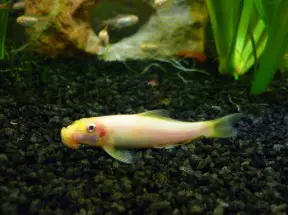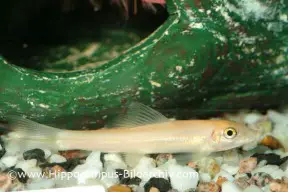Gyrinocheilus aymonieri
Sucking 'Loach'
SynonymsTop ↑
Psilorhynchus aymonieri Tirant, 1883; Gyrinocheilus kaznakovi Berg, 1906; Gyrinocheilus monchadskii Krasyukova & Gusev, 1987
Etymology
Gyrinocheilus: from the Ancient Greek γυρῖνος (gyrinos), meaning ‘tadpole’, and χείλος (cheílos), meaning ‘lip’, due to the somewhat triangular, tadpole-like shape of the mouthparts.
aymonieri: named in honour of French linguist, archaeologist and explorer Étienne François Aymonier (1844-1929), who collected or helped secure the type series while serving as a representative for the French protectorate of Cambodia.
Classification
Order: Cypriniformes Family: Gyrinocheilidae
Distribution
Described from the mountains of Samrong Tong, Kampong Speu province, Cambodia but is widely-distributed in the Mae Klong, Chao Phraya, Middle/Lower Mekong and Dong Nai river basins in Thailand, Laos, Cambodia and Vietnam.
It’s often seen on sale under the trade names ‘Indian’ or ‘Chinese’ algae eater but does not occur naturally in either country.
Habitat
Inhabits flowing streams and tributaries with substrates of boulders, pebbles, gravel and sand, often in areas with submerged driftwood or tree roots.
The frequently clear, shallow water allows sunlight to penetrate the surface and the development of a rich biofilm covering submerged surfaces upon which the fish browse.
It’s thought to undergo seasonal migrations during which it can be found in deeper, more turbid water and may enter temporarily-inundated zones.
Maximum Standard Length
200 – 280 mm.
Aquarium SizeTop ↑
An aquarium with base dimensions of 150 ∗ 45 cm should be the smallest considered.
Maintenance
Provided sufficient cover is available this species is relatively unfussy in terms of décor, and should not harm softer-leaved plants. However it will thrive in a set-up designed to resemble a flowing river with a substrate of variably-sized rocks, gravel and some larger, water-worn boulders.
This can be further furnished with driftwood roots and branches plus aquatic plants from genera such as Microsorum, Bolbitis, or Anubias which can be grown attached to the décor. Bright lighting will promote the growth of algae upon which the fish will graze.
Like many fishes that naturally inhabit running water it’s quite intolerant to the accumulation of organic wastes and does best if there is a high level of dissolved oxygen and moderate water movement.
Water Conditions
Temperature: Active over a wide temperature range of 60 – 90°F/16° – 32°C. Prolonged exposure to conditions towards either extreme of this range is not recommended however and this fish should be kept in a heated aquarium at 22 – 26 °C for general care.
pH: 6.0 – 8.0
Hardness: 36 – 357 ppm
Diet
Primarily an aufwuchs grazer feeding on algae, small crustaceans, insect larvae, etc., and for it to develop its best colours and condition it should be offered regular meals of small live and frozen foods such as bloodworm, Daphnia and Artemia, along with good quality dried flakes, granules and fresh plant material.
Shelled peas, cucumber, blanched courgette, spinach, and chopped fruit all make good additions to the menu, and home-made, gel-based foods using a mixture of natural ingredients are also highly recommended.
Once settled it will often ascend into midwater to feed and in a stream-style set-up as described above will be seen browsing the biofilm that tends to form on the rockwork.
Behaviour and CompatibilityTop ↑
Though normally sold as such this species is largely unsuitable for the general community aquarium. This does not mean to say it must be kept alone, rather that tankmates must be chosen with care.
While small specimens tend to hide away much of the time they become increasingly territorial as they grow and can display particularly high levels of aggression towards similar-looking fishes such as Crossocheilus, Epalzeorhynchos, or Garra spp.
Other bottom-dwelling fishes including cichlids and most catfishes are best avoided as they may be picked on it may even attach itself to the flanks of larger tankmates in order to feed on their body mucus.
For the upper levels choose robust, active cyprinids, characids, or similar. Ideally it should be the final addition to the tank in order to avoid it claiming ownership of the entire space.
Keeping a group is one way to reduce intraspecific aggression but at least half-a-dozen or more individuals should be purchased because they will develop a distinct pecking order and in lesser numbers weaker individuals are more easily targeted. It goes without saying that a very large tank would be needed in order to attempt such a project.
Sexual Dimorphism
Sexually mature females are noticeably thicker-bodied than males but it is impossible to accurately sex young fish. When in spawning condition adult males develop noticeable tubercules on the snout.
Reproduction
As far as we know it hasn’t been bred in aquaria but is farmed for the trade in large numbers with the aid of hormones.
NotesTop ↑
This species is among the most well-known fishes in the aquarium trade but juveniles are typically being offered for sale with little to no information regarding temperament, eventual size, and potential age which can be in excess of 15 years.
Wild examples are not currently traded, with all of those seen on sale produced on a commercial basis. There also exist several ornamental strains including albino, ‘golden’, ‘piebald’ and ‘short-bodied’ forms.
The golden variety is sometimes subjected artificial dying, an undoubtedly painful process which involves injecting the fish repeatedly with coloured dyes and normally leads to a significant reduction in lifespan.
Despite often being sold as such this species is not a loach although it was was initially considered a member of the former subfamily Homalopterinae. The results of an investigation regarding its karotype suggest it to be most closely-related to the families Cobitidae and Homalopteridae.
There are currently three described species although neither G. pennocki (native to the Mekong basin) or G. pustulosus (Borneo) are normally available in the aquarium trade. The former is the most similar in appearance to G. aymonieri but is distinguished by the presence of dark spot-like markings in the fins.
Gyrinocheilus species exhibit some morphological peculiarities which separate them from all other genera in the order Cypriniformes. They lack pharyngeal teeth and possess a small, spiracle-like aperture at the top of each opercle.
The latter are used as secondary respiratory openings through which water enters and passes over the gills before being expelled via the principal gill opening. The mouthparts can therefore be used independantly for feeding and anchoring to solid surfaces.
They also lack barbels, further distinguishing them from similar-looking fish such as Garra cambodgiensis, Epalzeorhynchos kalopterus and laterally-striped Crossocheilus spp.
References
- Tirant, G., 1883 - Bulletin de la Société des Études Indo-chinoises. Saigon: 167-173
Note sur quelques espèces de poissons des montagnes de Samrong-Tong (Cambodge). - Arai, R., A. Suzuki and Y. Akai, 1988 - Japanese Journal of Ichthyology 34(4): 515-517
The karyotype and DNA value of a Cypriniform algae eater, Gyrinocheilus aymonieri. - Kottelat, M., 2013 - The Raffles Bulletin of Zoology Supplement 27: 1-663
The fishes of the inland waters of southeast Asia: a catalogue and core bibiography of the fishes known to occur in freshwaters, mangroves and estuaries. - Rainboth, W. J., 1996 - FAO, Rome: 1-265
Fishes of the Cambodian Mekong. FAO Species Identification Field Guide for Fishery Purposes.






